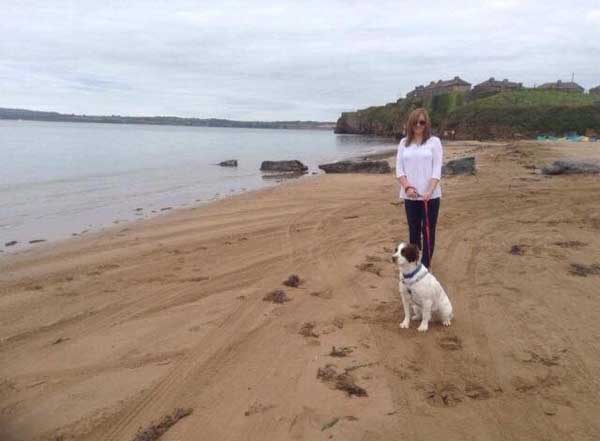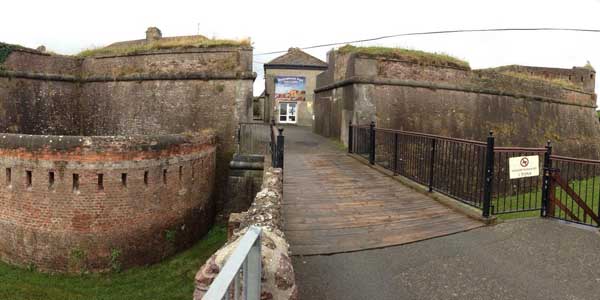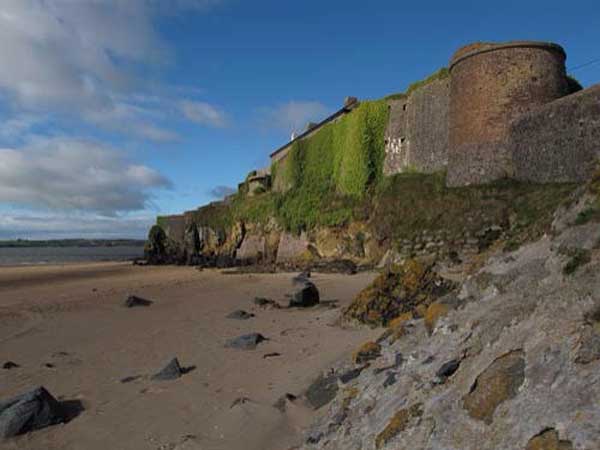Duncannon Fort in Co. Wexford is an amazing presentation of a bastioned fortress positioned on the side of the stunning Hook Peninsula. It’s a fantastic place to go for a walk on the beach, camp out under the stars and get to know the locals of Wexford.
Contact Details.
Duncannon Fort,
Duncannon,
Hook Peninsula,
New Ross,
County Wexford.
+353 (0)51 389 530
www.visitwexford.ie
info@hooktourism.com
Admission to Duncannon Fort
€6.00 – Adult (€1 dicsount when you show a Hook Lighthouse Tour receipt)
€1.50 – Children (6-16)
Under 6 – no charge
Opening Times of Duncannon Fort
Open May – September.
Summer opening 7 days a week.
Tour Details
Tours of Duncannon Fort are by Guided Tour.
Please arrive 10 minutes before tour time.
Guided Tours of Duncanon Fort last approximately 45 minutes.
Tour Times.
11.00am, 12.15pm, 1.30pm, 2.45pm, 4.00pm.
History and Information on Duncannon Fort

Located in the beautiful town of Duncannon, Co Wexford. With outstanding views of River Estuary, completely open to the wild elements that sometimes batter this region of Ireland. Duncannon is a town with a stunning picturesque harbour and a long beautiful beach that has amazing views.
With its panoramic views the charming holiday and seaside village of Duncannon is a beautiful and wonderful location to visit. Duncannon is also located on The Norman Way in County Wexford and is part of Ireland’s Ancient East.
It is said that there has been a settlement at this location since the time of Fionn Mac Cumhaill and the legendry Fianna. Duncannon has always held importance as a point of stragic military importance along the River. It protected the internal reaches of the River and protected major towns within Ireland.
Duncannon Fort is home to a magnificent, perfectly built and preserved Military Fort situated high over the village of Duncannon, Co Wexford. Duncannon Fort overlooks out over the mystical Estuary of The Three Sisters (The Rivers, Barrow, Nore and Suir) Duncannon Fort has protectively watched out over The Estuary since 1587.
Constructed of beautiful and vibrant red sandstone Duncannon Fort is a Star Fort, also known as a Bastion Fort or a Trate Italle, whose design was first seen in 15th Century in Italy.
It is a style of fort that came into existence as the age of gunpowder changed the world and the sound of terrifying cannon fire started to dominate the world’s battlefields. Star Forts are pentagon or hexagon in shape with bastions situated at the wall corners. The use of bastions allowed for the use of artillery protection.
The design and shape of the Star Fort also allowed for a panoramic view of the estuary, allowing the Fort’s garrison a clear view of all areas they were guarding.
Duncannon Fort’s artillery batteries protectively covered all angles of the river Estuary, allowing for protection on all side of this amazing Fort.
Duncannon Fort was protected on its landward side by an angled Redan, which is a v-shaped Salient, with a deep defensive the ditch and the old mediaeval wall. A caponiers also protected this ditch.
All the counterscarp galleries (tunnels inside the ditch) each had a Sally port (controlled entrances). All these features enabled the garrison to enter the ditch undetected.

The Fort we see today at Duncannon was not the first defensive fortress on this site. There was a Norman fortress here that would have dated from the 12th century.
This Fort would have possibly replaced a Native Irish defensive feature. The Fort we see today at Duncannon was commissioned by Queen Elizabeth I, in approximately 1588.
Its purpose was to protect Waterford from a possible invasion by the Spanish Armada, which was one of the biggest threats during her long reign.
During The Irish Confederate War, Duncannon Fort saw a major artillery action, while the Fort was under the command of The Royalist Governor Laurence Esmonde, the 1st Baron Edmond.
Duncannon was put under siege by the Irish Catholic Confederate Forces lead by Thomas Preston, 1st Viscount Tara.
This vicious military onslaught was the first time mortars were used in Ireland. In 1649 Oliver Cromwell tried and failed to retake Duncannon but in 1650 Duncannon surrendered to Cromwell’s Son in law Henry Ireton, who also managed to take the City of Waterford.
In the late 17th century, Duncannon hosted two Kings, James II and later William III. King James’s Hole located in Duncannon is the site from which The King set sail for Kinsale.
Duncannon Lighthouse was built in 1774 and is still in use today. During the 1798 Rebellion, Duncannon was one of the very few posts that did not fall into the hands of Rebel forces. It did however become a safe haven for retreating troops and those people who had remained loyal to The Crown.
Duncannon Fort was used as a prison for the Irish Rebels and many were executed here. The Fort is famously the site where The Croppy Boy was executed, a death that was immortalized in the song “The Croppy Boy”, one of Ireland’s most famous songs.
As you walk through the gates of this building it is almost possible to hear the words of the song echo through time, hearing the pain and suffering of that boy that died without a name.

Duncannon Fort remained in the hands of The British Army until it was handed to the Irish National Army in 1922 and was burned down during The Irish Civil War.
Duncannon Fort was given to Wexford County Council in 1993 and now operates as a wonderful visitor attraction and Heritage Site. It is one of the best-preserved Star Forts in Ireland. As you walk to this magnificent Fort you are transported back in time, to an age of war and hostility.
It seems to still be home to the ghosts of those who were executed here, whispers of our past and turbulent times in Irish History. It is a wonderful historical location, which gives you a unique experience and allows you to become immersed in out wonderful past.

